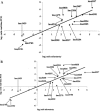Intracellular gene expression profile of Listeria monocytogenes
- PMID: 16428782
- PMCID: PMC1360297
- DOI: 10.1128/IAI.74.2.1323-1338.2006
Intracellular gene expression profile of Listeria monocytogenes
Abstract
Listeria monocytogenes is a gram-positive, food-borne microorganism responsible for invasive infections with a high overall mortality. L. monocytogenes is among the very few microorganisms that can induce uptake into the host cell and subsequently enter the host cell cytosol by breaching the vacuolar membrane. We infected the murine macrophage cell line P388D1 with L. monocytogenes strain EGD-e and examined the gene expression profile of L. monocytogenes inside the vacuolar and cytosolic environments of the host cell by using whole-genome microarray and mutant analyses. We found that approximately 17% of the total genome was mobilized to enable adaptation for intracellular growth. Intracellularly expressed genes showed responses typical of glucose limitation within bacteria, with a decrease in the amount of mRNA encoding enzymes in the central metabolism and a temporal induction of genes involved in alternative-carbon-source utilization pathways and their regulation. Adaptive intracellular gene expression involved genes that are associated with virulence, the general stress response, cell division, and changes in cell wall structure and included many genes with unknown functions. A total of 41 genes were species specific, being absent from the genome of the nonpathogenic Listeria innocua CLIP 11262 strain. We also detected 25 genes that were strain specific, i.e., absent from the genome of the previously sequenced L. monocytogenes F2365 serotype 4b strain, suggesting heterogeneity in the gene pool required for intracellular survival of L. monocytogenes in host cells. Overall, our study provides crucial insights into the strategy of intracellular survival and measures taken by L. monocytogenes to escape the host cell responses.
Figures





References
-
- Abachin, E., C. Poyart, E. Pellegrini, E. Milohanic, F. Fiedler, P. Berche, and P. Trieu-Cuot. 2002. Formation of d-alanyl-lipoteichoic acid is required for adhesion and virulence of Listeria monocytogenes. Mol. Microbiol. 43:1-14. - PubMed
-
- Arous, S., C. Buchrieser, P. Folio, P. Glaser, A. Namane, M. Hebraud, and Y. Hechard. 2004. Global analysis of gene expression in an rpoN mutant of Listeria monocytogenes. Microbiology 150:1581-1590. - PubMed
-
- Asanuma, N., and T. Hino. 2003. Molecular characterization of HPr and related enzymes, and regulation of HPr phosphorylation in the ruminal bacterium Streptococcus bovis. Arch. Microbiol. 179:205-213. - PubMed
Publication types
MeSH terms
Substances
LinkOut - more resources
Full Text Sources
Other Literature Sources
Molecular Biology Databases

